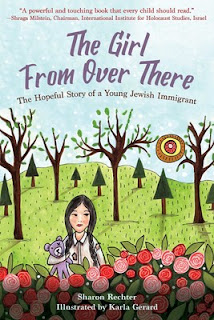Review: The Girl from Over There
The Girl from Over There: The Hopeful Story of a Young Jewish Immigrant by Sharon Rechter, illustrated by Karla Gerard
An unnamed Israeli kibbutz, post World War II, is the setting for this work of historical fiction. A tattered and terrified 11 year old girl, Miriam, has arrived from “over there.” The adults in the kibbutz welcome her, but 11 year old Michal, self described as the “class queen,” is consumed by jealousy and hatred. While Michal’s clique are initially suspicious and cruel, soon only Michal continues to play mean tricks. Not surprisingly, Miriam returns Michal’s hatred. However, Miriam, helped by Michal’s boyfriend Dan, learns to accept her new surroundings, and decides to reach out to Michal. As more new arrivals are welcomed and tell their stories of the horrors of the war. Michal gradually comes to understand how much Miriam has suffered, and after much hesitation apologizes.
Written when Sharon Rechter was 11, the book shows great understanding of how an 11 year old Michal’s mind works, her uncertainly and fear of losing her place. However, Miriam does seem to make the change in her attitude very quickly for one so deeply traumatized. Other characters are less well developed. Dan seems a stereotypical good boy. Leah, a mother figure on the kibbutz, is moved to the point of breakdown by the newcomers’ stories, but do we believe she would tell her story to the children? In the context of the story, the ending is quite possible, but does it seems too good to be true?
In addition to adding to the Holocaust literature, this story has the added benefit of demonstrating the value of accepting, understand, and overcoming differences.
The Girl from Over There tells an important Holocaust story, and it also deals with Jewish values of chesed, kindness, and self reflection leading to t'shuvah, repentance. Kindness to all, including those who are very different, is an inherent part of the story. These values, integral to life on the kibbutz, help Michal grow past her initial hatred and jealousy. The author has included what seem to be actual testimonies and memories, presumably based on stories heard from her grandparents. As this is historical fiction, we have no way to attribute the stories, but they fit the pattern of what we have learned elsewhere.
The question of age appropriateness for Holocaust materials is a thorny one, as material appropriate for one 8 or 9 year old is in appropriate for another and there is a huge difference between an 8 year old and an 11 or 12 year old. There is a huge gap between the style, vocabulary, format, and illustrations of this book, which are appropriate for an 8 year old, and the text, which includes horrific Holocaust stories. I fear the illustrations and font would be off putting for a 12 year old, and certainly for the teenager who has ever felt excluded. A 12 year old, however, is more capable of grappling with the stories. The footnoted explanations of various words and concepts also present a problem. Younger children in this age group would need to seek adult help.
Are you interested in reviewing books for The Sydney Taylor Shmooze? Click here!
Reviewer Judith S. Greenblatt says: I hold a Master of Library Service from Rutgers-The State University, and a Master of Arts in Jewish Studies from Hebrew College, Newton, Ma. I started my career as a Judaic Librarian as Librarian at the Michael Lichtenstein Memorial Library, Temple B'nai Israel, Toledo, Ohio. Subsequently I was Librarian at Temple Sinai, Cranston, RI, Congregation Mishkan Tefila, Brookline, Ma, and finished as Director of Library Services at the Bureau of Jewish Education of Rhode Island. I have been a member of the Association of Jewish Libraries since 1977, served on and chaired Weine Cataloging Revision Committee, and served as Vice President and President of the School, Synagogue and Center Division of AJL. Publications include: 1985-86 Book lists; for young children, for 3rd to 6th graders, for young adults. Annotated. Women's League for Conservative Judaism, 1986. 100 Plus Books For The Children's Library: A Basic Collection. Revised in cooperation with the Publications Committee of the Association of Jewish Libraries. Association of Jewish Libraries, 1989. Weine Classification Scheme for Judaica Libraries. Revised by Judith S. Greenblatt, Chairman. 8th edition. Association of Jewish Libraries, Synagogue, School and Center Division, 1994.



Comments
Post a Comment